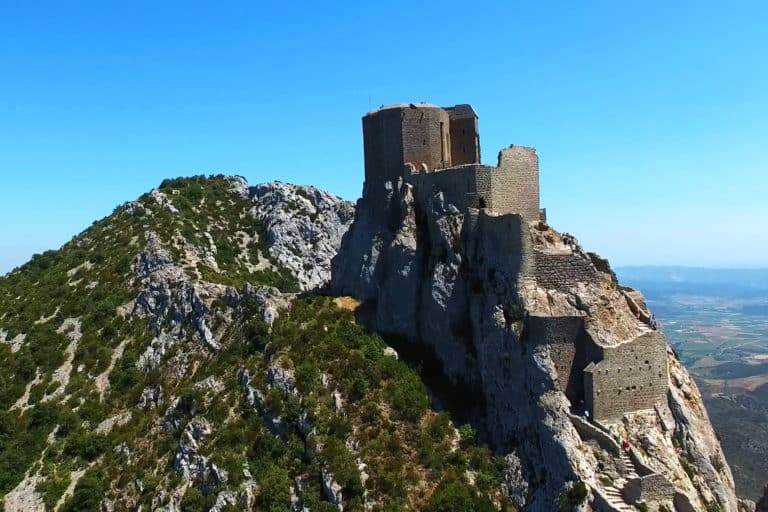In the heart of Occitania
Between the Massif Central and the Pyrenees, the department of Aude shelters the jewels of our department: The Cathar castles. A dozen fortified villages set in a wild and spectacular setting.
13 medieval citadels and among the most famous, the Castle of Queribus perched at 728m altitude, further south the Castle of Peyrepertuse: the pierced stone in Occitan; but also the Medieval City of Arques classified as World Heritage by UNESCO. And finally, on the border of the Aude and the Pyrénées Orientales: the Château de Puylaurens. The fortress is placed on the Mount Ardu. Less known, on a rocky spur which dominates the Gorges of Terminet, the vestiges of the Castle of Termes.
These 8 castles of breathtaking beauty and their exceptional history will immerse you in the fascinating epic of Catharism.
To leave our campsite and our beautiful department of Aude without having seen and visited the Cathar castles is not possible. Go for a hike to discover these breathtaking citadels and at the same time our fabulous landscapes.
The short story:
The Cathars are members of a religious movement that developed between the 10th and 13th centuries in several parts of Europe, particularly in the South. In this region they represented 2 to 5% of the population.
The Cathars did not call themselves Cathars at the time, this name only appeared in 1960, 700 years after they lived. They called themselves Good Christians and the others, who were not Cathars, called them the Perfects or Albigensians because they lived around the Albigensian territory.
At that time, it is the time of the crusades, for the first time in 1209, the Pope Innocent III will declare a crusade against the Christians, against the good Christians that are called “the albigensians”. This is called the crusade against the Albigensians.
France was in the feudal system, that is, the royal territory was very small and all the rest of the territory was autonomous duchies and counties. The lords of these duchies and autonomous counties see in the crusade a good opportunity to conquer new territories, the territory of the South and so they launch out in this crusade; they besiege Béziers, Arques, they conquer all the Albigensian region and when they arrive at Toulouse they are pushed back.
From 1226 onwards, Louis IX took things in hand because he had a policy of unifying the territory and he saw in the crusade against the Albigensians an opportunity to conquer the Midi and to bring it back under the French crown. This time, he will lead the royal army against the Cathars.
The people of the South are conquered rather quickly. The primary objective of the crusade against the Albigensians was to eradicate all Cathar heretics, which has not yet been accomplished.
The new Pope Gregory IX will decide to set up the inquisition, it is a court led by the church and which judges the heretics of which those who do not believe in the official version of Christianity and they have two choices:
Either they convert to Christianity and are detained for life.
Either they decide to keep their heretical faith and they are burned at the stake.
So the inquisition will be set up in this region and the Cathars and the people of the South will take refuge in citadels on the top of the hills. In one of these citadels called Montsegur there will be a 10 month siege in which the Cathars refused to convert to official Christianity and they will be burned alive inside this fortress.
From then on, it was the end of all organized resistance and the fortresses fell one by one like the Castle of Puylaurens and that of Queribus.
The Cathars were exterminated (they survived until the 14th century). The citadels are therefore neglected, but they are in a strategic location because they are situated along the border with the Kingdom of Aragon. Louis IX, who had just conquered this territory, wanted to defend it and therefore razed these small castles and built real fortified citadels all along the border, which are now known as the Castles of the Cathar Country.
The Cathar castles were not built by the Cathars and the Cathars never lived there.
And among these castles, Louis IX will build the 5 castles that are called “The five sons of the Castle of Arques” which are the castle of Aguilar, Peyrepertuse, Puylaurens, Termes and Queribus.
These castles have housed a garrison for 400 years. But in 1659 Louis XIV signed the Treaty of the Pyrenees, which moved the border of the Kingdom of Aragon to the current border of the Southern Eastern Pyrenees.
All the castles of the Cathar country lost their strategic location and were gradually abandoned. There were still a few garrisons that remained until the French Revolution, but from then on they were totally abandoned and forgotten.
It is in the XXth century that historians have looked back on this history and these citadels to give them a second life.









